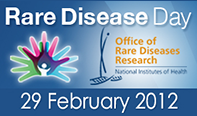Every day is Rare Disease Day at the NHLBI
Dr. Carl Roth - February 28, 2012
 |
With the fifth annual Rare Disease Day nearly upon us — it is scheduled for this Wednesday, Feb. 29 — I began to reflect on some of the successful NHLBI collaborations with public interest organizations focused on rare diseases that I have seen over my (long) career with the Institute, which welcomes collaboration on any cardiovascular, lung, blood, or sleep manifestation of a disease.
One of my first experiences in working with advocates for research on rare diseases began with a letter-writing campaign. We were asked what we were doing about LAM — and the truth is that many of us at the NHLBI did not even know what LAM was. Let me assure you that we do now because of what became a long-standing engagement with the LAM Foundation.
Most of the public interest organizations focused on rare diseases start as grass-roots efforts, often founded by loved ones of an affected patient. That was certainly true of the LAM Foundation. Lymphangioleiomyomatosis, or LAM, is a rare, fatal disease in which an unusual type of muscle cell invades the lungs. It affects several hundred patients in the U.S., mostly women. The LAM Foundation and the NHLBI have now worked together for over 15 years, and we have a LAM registry and a LAM tissue and blood bank to show for our collaborative efforts. Research based on NHLBI and LAM Foundation interactions led to the discovery of a key gene associated with the development of LAM and the elucidation of important molecular interactions involved in the disease process.
Our work with the National Marfan Foundation is another good example. Marfan syndrome, which affects about 1 in 5,000 people in the U.S., is a disorder of connective tissue. Among other manifestations, the condition damages the heart and blood vessels and often results in a dangerous stretching of the aorta that can lead to an aortic aneurysm and possibly a fatal rupture. The National Marfan Foundation (NMF) and the NHLBI have worked together for 10 years, establishing, along with the National Institute of Arthritis and Musculoskeletal and Skin Diseases, a registry that furthers research and understanding of the disorder. Perhaps the biggest achievement resulting from our collaborative efforts is a clinical trial sponsored by the NHLBI that is comparing two drugs in terms of their ability to prevent aortic aneurysms. The NMF has not only promoted participation in the trial among its members but also urged them not to seek treatment with the more promising of the two drugs outside the trial. The NMF has also provided financial support to cover some trial-related participant costs and for studies that will complement the trial.
While the potential direct benefit to patients with rare diseases is, of itself, sufficient reason for supporting research on rare diseases, such studies can also often provide important insights into other diseases that affect large numbers of people. Here are three examples. Much of what we know about atherosclerosis can be attributed to research on rare disorders in lipid metabolism. Research on alpha-1 antitrypsin disorder has informed research on emphysema in general. Hutchinson-Gilford progeria syndrome, a rare condition that affects about 1 in 4 million to 8 million newborns, causes premature aging, including heart disease, in children. The discovery of the gene believed to be responsible for progeria resulted from efforts of Progeria Research Foundation (PRF) staff, scientists working at the NIH, and scientists in universities and medical centers who have received NIH support. The PRF developed resources for families with affected children and has worked to find and enroll children from around the world in clinical trials designed to assess a possible new therapy.
So I think that the bottom line here is that we at the NHLBI are always willing and eager to work with advocates for rare disease research to develop and support basic and clinical research efforts that will lead to new treatments for all diseases, whether they affect few or many. For us, every day is Rare Disease Day.
Learn more:
















